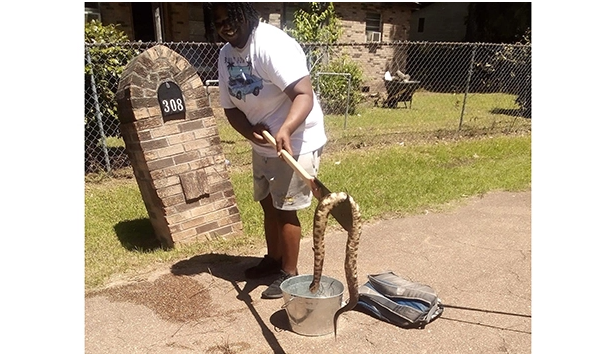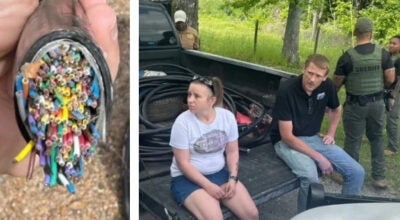Snakes are on the move in Mississippi. Residents cautioned to be alert as temperatures heat up.
Published 12:09 pm Tuesday, May 2, 2023

- Jay Perkins holds up a cottonmouth/water moccasin he killed on Brignall Road last Monday. He encountered the snake while fishing at a pond and decided to take action. (Submitted Photo | The Daily Leader)
Snakes are on the move with warmer weather, and Jay Perkins of Brookhaven came across a fat cottonmouth last Monday.
The snake was on Brignall Road by a pond in Lincoln County.
Perkins said he was fishing when he watched the snake slither to the pond’s bank and sit there.
Cottonmouths, or water moccasins, make their homes near water. They eat fish, frogs, snakes and other reptiles, small birds, and mammals.
They can become irritable when cornered and show their cotton-white mouth when threatened.
Mississippi Department of Wildlife, Fisheries and Parks recommends people treat all snakes found in water areas with caution.
This increased number of snake encounters in the spring is mostly due to the movement of the reptiles from one seasonal habitat to another. Because snakes are cold-blooded animals, they rely on external sources of heating and cooling, such as the sun or a patch of shade, to regulate their body temperature. In the winter, snakes seek warm dens in burrows, stumps or piles of wood and brush where the temperatures are higher than the surface. During this time, snakes rarely eat as they go into a long period of inactivity.
When outside temperatures increase in the spring, snakes become more active as they search for food. They also bask in sunny areas and move to find mates or give birth. Young hatchlings will begin to move as temperatures rise, so it appears there is also an increase in the number of snake sightings this time of year.
Perkins decided to take action so he could resume fishing.
“He sat there when I was approaching. I trapped it with a rock and then started poking it with my sling blade,” Perkins said. “I was fishing at first until I saw it. It was so big I was like, ‘I can’t let him just be around here.’”
Mississippi is home to six venomous snakes and 49 nonvenomous snakes.
MDWFP encourages people to leave snakes alone when they encounter them due to the role they play in the ecosystem.
If you are working in areas that might attract snakes, such as an area that provides good cover or has abundant rodents, be cautious that a snake encounter may occur. If you spot a snake, let it move out of the vicinity before resuming work. If you see a venomous snake — such as a copperhead, rattlesnake or cottonmouth — be sure to keep children and pets out of the area until you are certain the snake has moved on its way.
Always supervise children and pets in areas where there might be snakes, and teach children to respect animals and leave snakes alone. If a nonvenomous snake bites you, a horseshoe-like pattern of scratches will appear. This minor injury will require nothing more than some topical antibiotic and perhaps a bandage.
If a venomous snake bites you, you will see distinct fang puncture marks and possibly oozing of blood. Even with the fang marks, the bite may be a “dry bite” or absent of venomous injection. Stay calm and get immediate medical attention. Remove any restrictive clothing — do not apply a tourniquet — and keep the bitten area below the level of your heart.
Keep in mind that most snakebites are not fatal if treated immediately. An accurate description or identification of the snake will help medical personnel treat the wound quickly and properly.
Snake bites can also occur when a person is trying to kill a snake. Physician-treated venomous snake bites have a mortality rate of less than 1 percent.
More News





